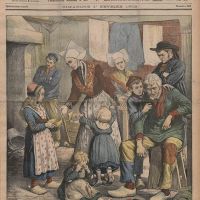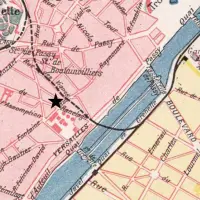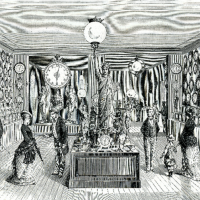We don’t often think of Paris as a port city. But the city handles about 20 million tonnes of cargo a year, and with more than 7 million people travelling on the river each year, Paris is the leading river port in Europe for passenger transportation.
A hundred years ago, it was more than just passenger traffic. All kinds of products were shipped along the Seine: construction materials, farm products, fuel.
I gravitate to postcards of the working river and snap them up when I see affordable ones. Here is one of my favourites. Notice the white-shirted deckhand near the stern lowering the smokestack so that this boat can get under the Pont au Change.
Many of the postcards refer to different “ports” within the city. Each one was associated with a particular product. I was curious about the covered barges or péniches that came in to the Port de l’Hôtel de Ville shown in this postcard.
Apparently this was the place where apples were brought in from Normandy and unloaded underneath the windows of Paris’s city hall. At the quai, the apples were loaded by hand into baskets or paniers and handed up to the next worker.
Once up from the hold, workers had to carry the heavy baskets across a narrow gangplank to the quai. It was tiring and potentially dangerous work, particularly in bad weather.
One of the more famous specialized port areas was Bercy, where wine was unloaded. It grew to become the major wine warehousing area – not just in France, but in the world.
Les Halles de Bercy represented the wine equivalent of the Les Halles food market. And like the food market, the area fell on hard times in the mid 20th century. In the 1970s, when Les Halles was demolished, the Bercy area had fallen into ruins. Today, it is a redeveloped area with a park that preserves some of the old wine storage sheds or chais.
My image of Bercy shows it looking desolate during the flood of 1910. That is the customs shed underwater.
Other quais were the specialized sites for unloading bulk commodities such as plaster or coal.
Not far from Bercy, the port d’Austerlitz handled bricks. Yet all this workaday activity co-existed with passenger traffic, recreation, and other activities.In this postcard of the Quai d’Austerlitz, sent in 1906, notice the advertisements for Chocolat Menier, Benedictine and “La Mutual Life,” and the “Bain d’Hommes – 30 centimes” on the far bank. At a time when many apartments were rather rudimentary in terms of water and sanitation, low-priced public bathing places were an important part of public health measures.
In many ways, it is this kind of extraordinary detail and variety that attracts me to these images.
The postcard below shows the Port Saint-Nicolas, where a river boat from Rouen is unloading sacks (possibly containing plaster or lime). The Pont des Arts is in the background, which means that the Port Saint-Nicolas (now long gone) is right in front of the Louvre, and indeed, this area was also known as the Port du Louvre.
Notice the floating men’s swimming school beyond the piled-up sacks (Ecole de Natation du Louvre. Hommes).
In the next postcard, we see the same swimming school, but this view shows more activity on the quai and some passenger or pleasure boats in the river. But the same Rouen boat is tied up in roughly the same place. Perhaps it was a fixture in this spot.
The vantage point is identified as the Pont des Saints-Pères, today the Pont du Carrousel.
This third postcard is taken from the busy port, looking back at the bridge, as it was then. And, yes, it looks like the same Rouen boat once more.
What happened to the Pont des Saints-Pères? The website for the City of Paris tells us:
This first structure comprised a major technical innovation. It was designed by the engineer [Antoine-Rémy] Polonceau, who fought tooth and nail to have his project accepted in the face of opposition from the partisans of a suspension bridge. He even went as far as to finance the initial foundation work from his own pocket. The very lightweight structure consisted of three equal main arches, each of which itself comprised five composite wood and cast iron arches supporting a wooden deck. Although daring, this structure was nonetheless fragile, and in 1883, the bridge was closed for six months for replacement of some of the beams and cross-members. The technicians took this opportunity to suggest replacing the wooden deck with beaten [that is, wrought] iron, which was in fact done, but not before 1906. However, the structure was still extremely flexible and with the growth in the volume and weight of traffic, it shook and bounced disconcertingly.
Eventually, the bridge was replaced with the concrete structure that now crosses the river at this point.
Many people lived on houseboards and barges. The postcard below, which was mailed in 1904, depicts a rather ramshackle scene in which working and living are haphazardly mingled.
You can just see the Eiffel Tower on the right. This would have been in the river just off the 15th arrondissement and may have been taken from the Pont Mirabeau. The water level is very low, and a motley set of walkways connects the barges and houseboats to the shore.
Today Paris is famous for its ubiquitous sightseeing boats – bateaux mouches – as well as boats for dining and entertainment. The idea of floating entertainment and sightseeing is well represented in early photos and postcards. In the image below, in addition to the magnificent Pont Alexandre III, one of the enduring monuments from the Exposition of 1900, we see a typical Parisian combo: tourist passenger boats cruising the river and two permanently moored entertainment vessels, with the promise of live piano music.
The great flood of 1910 was hard on floating places of entertainment like this. In the following postcard, the forlorn little boat in the middle is either the same as the boat second from the right in the postcard above, or one very like it. This was taken farther upstream, showing the nearly drowned Passerelle Debilly, which I wrote about in an earlier blog.
These are just a few of the many postcards I have collected of the working river. Perhaps I will show some others in a future blog.
I will end with a view of the Bassin de l’Arsenal, looking towards the Colonne de Juillet in the Place de la Bastille. Note the barges full of sand and gravel.
Today, the same view shows pleasure boats and leisure. But they, too, are a form of work for their owners and caretakers.
The Seine is still a working river, even as the work changes.
Text and original photograph by Norman Ball.

































Thank you for yet another interesting piece of the history of Paris. Each of your newsletters provides a new view of Paris and it’s history. It will add to my pleasure as I walk the Seine in September and add to my understanding and appreciation. I also collect postcards of Paris and will look for ones depicting the history of the Seine.
Dear Norman:
As always, most enjoyable.
A couple questions.
The statistic of 7 million current passengers a year on the river is striking. What proportion are doing short trips, sightseeing or dinner +, in the neighbourhood of Paris? Is there any substantial passenger traffic going 50km or more?
And another question. Re the 6th card you note “La Mutual Life”. This is an English name. Can it be the Mutual Life of Waterloo, Ontario? That Mutual Life was already going strong in 1906!
Regards
Doug
Sent from my BlackBerry device on the Rogers Wireless Network
Thanks for your interest and comment Doug. The passenger number comes from the Port de Paris website. There is no breakdown but I am sure that almost all are for trips inside Paris or very nearby. I have seen various figures and 7 million is not the lowest.
As regards the Insurance company I am still looking into that one.
Norman
Excellent story and so informative! Thanks once again Norman, I’m back from four months in Paris last night and am already thinking of the white asparagus and strawberries I am missing!
Marnie KM
gnhlth
It is great to view the different uses of the Seine and how they brought the building materials to build their structures.
Ooh I can see I’m going to love your blog; I’m so happy you found mine! You seem to be one of those hardcore postcard collectors…I’m sure you’re no stranger to Passage des Panoramas and the other covered passages in Paris, stuffed with all those great old postcards. 🙂
I love to see others so passionate about Paris, and I look forward to browsing your blog further.
Pingback: The Paris Blog: Paris, France Expat Tips & Resources »Blog Archive » The Working River
What a wonderful piece, thanks so much for putting this up. I’m trying to find out more about the ports of Paris at the moment, but am stymied a bit by my lack of French. Do you know if the ports you mention (Bercy, Austerlitz) are still working ports? If not, have you any idea when they might have been decommissioned?
By ‘port’ I meant ‘dock’, apologies!
Pingback: Postcards: Little windows into a vanished Paris | Parisian Fields